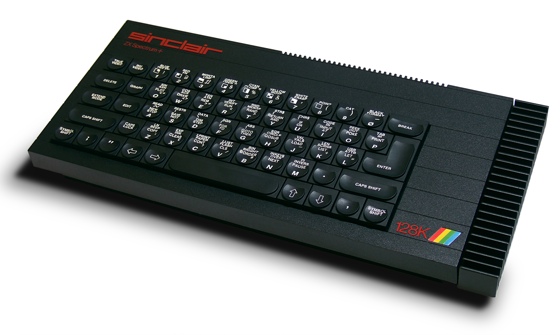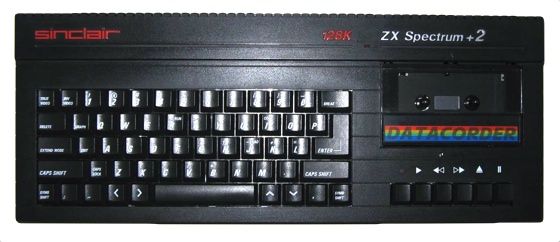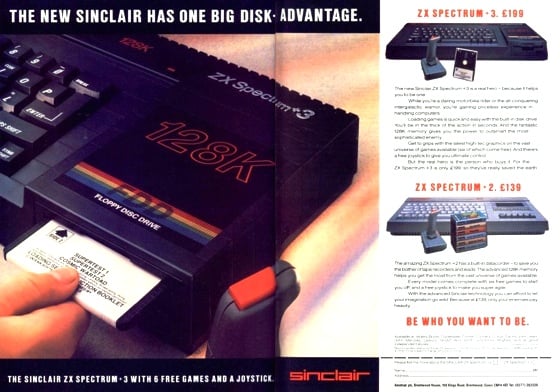This article is more than 1 year old
Happy 30th Birthday, Sinclair ZX Spectrum
The story of an historic micro
Mined out
By mid-1984 the once seemingly unstoppable Spectrum was starting to run out of steam over here too. Sinclair had tried and spectacularly failed to enter the business computing market with the Motorola 68000-based QL, had commanded all of Sinclair's product development resources, leaving no room for work on a true Spectrum successor for the home market. So the Spectrum was tweaked again: a new, more rectangular, QL-style casing with hard plastic keys, creating the Spectrum+.
But with no other changes to the core Spectrum specification and a higher price - £179.95 - punters were not overwhelmed by the new Spectrum+ when it went on sale in October 1984. To make matters worse, Sinclair's quality control slipped (again) leading to high failure rates. If the Spectrum+ you bought worked, there was still a good chance one of more of the keys would come loose and fall off.

Hot sink ahoy! Sinclair's ZX Spectrum+ 128
Source: Bill Bertram, licensed under CC 2.5
Still, the Spectrum+ kept the brand alive through to February 1986 and the arrival of the Spectrum+ 128, which was, again, a regular Spectrum in a new case but this time with 128KB of Ram; MIDI output and three-channel sound courtesy of a new audio chip; an RS-232 port; and the ability to output to a monitor. And a big, very hot heat sink bolted onto the side.
Memory switching hardware ensured the Z80A CPU could flip between the two banks of 64KB making up the 128's memory map. It also had to handle switching between two 16KB banks of Rom, one for the original Spectrum Rom, the other for a new 128 Basic interpreter.
Sugar is the boss
By now, however, Sinclair was in trouble. A sudden, unexpected collapse in the home computer market in the run-up to Christmas 1984 hit the company hard, though its focus on low-cost machines ensured it didn't take the punishment meted out to many of its rivals, Acorn in particular. But the plunge ensured 1985 was a lean year, and Sinclair entered 1986 uncomfortably.
And was soon acquired by Amstrad, Alan Sugar's company, once known for its cheap but poor hi-fi and, at this point, for the well-received Amstrad CPC 64 home computer, which had gone on sale in June 1984, just as Sinclair was struggling to persuade buyers to upgrade to the QL.
Amstrad killed off the Spectrum 128 but maintained the Plus, understanding the benefit of a low-cost machine with a huge catalogue of games software behind it. Early in 1987, Amstrad released the Spectrum +2, a 128 with a new design featuring, as per the CPC series, a built-in cassette deck. It also removed the single-key Basic instruction entry system, a Sinclair trademark going back to the ZX80. Like the Plus, the Plus 2 was sold as a games machine - joysticks and a stack of games were bundled with the computer - pure and simple.
Having opted for a 3in, 350KB diskette system for its PCW-8256 word processor, launched in September 1985, and acquired a job lot of the non-standard storage media, Amstrad put a 3in diskette drive into a tweaked Spectrum +2 and released in it 1987 as the Spectrum +3. Like the PCW series, it could run the CP/M operating system out of the box, thanks to internal tweaks but the Plus 3 was again sold solely as a games machine.
Amstrad finally ended Spectrum production in 1990, though some sites put the date at 1988. Either way, the Plus 3 was the last home computer to carry the name. ®
The author would like to thank all those fellow enthusiasts for scanning and uploading so many adverts and manuals from the 1980s, without which this article would have been much less detailed.
Very special thanks also go to Rick Dickinson for his permission to use his sketches and design drawings.


